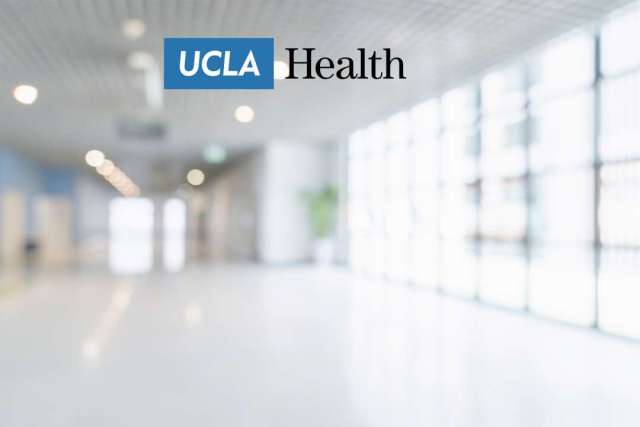Dr. Barbara Natterson Horowitz feels as much at home at the Los Angeles Zoo's Gottlieb Animal Health and Conservation Center as she does the Ronald Reagan UCLA Medical Center.
The UCLA cardiologist spends most of her days performing and analyzing cardiac ultrasounds of human hearts as the director of imaging for the UCLA Cardiac Arrhythmia Center. But when an urgent call comes from zoo veterinarians, you'll find her at the side of a chimpanzee with a leaky mitral valve or an African lioness with pericardial tamponade, a condition that occurs when fluid collects in the sac surrounding the heart.
Over the past six years, Natterson Horowitz has examined ailing gorillas, lions, South American tamarins, gibbons, orangutans, chimpanzees and even non-primates who require her expertise.
Natterson Horowitz is one of a dozen UCLA physicians who have extended their unstinting compassion for their human patients to ailing animals. She, along with nine other UCLA physicians and a campus veterinarian, serve as volunteers on the L.A. Zoo's Medical Advisory Board, making themselves available to the zoo's highly skilled veterinarians for assistance in especially perplexing cases.
"I feel it's a great privilege to be someone's doctor," said Natterson Horowitz, who has been an attending physician in cardiology at UCLA since 1994. "But it's equally thrilling when you think, 'I can help this sick lion.' It's been one of the great experiences of my life."
A mother who first met zoo veterinarians when her children were invited to a sleepover at the zoo, Natterson Horowitz can still recall her initial shock when she was called in for the first time to image the heart of Bonnie, an elderly chimpanzee.
"I do this same procedure on people all day long," she said. "But when I saw what looked almost like a human heart on the screen, I just stared at it. I shouldn't have been surprised - I took evolutionary biology like everyone else," and was well-aware that the chimpanzee genome is nearly 99 percent identical to the human genome. "But it was still an 'ah-ha' moment for me. I was so excited my own heart was beating fast."
The realization that the diseases and disorders that affect humans and certain animal species are similar, if not the same, has prompted Natterson Horowitz and medical journalist Kathryn Bowers, to coin the word "zoobiquity" to describe the physiology and pathophysiology across species. A book they are co-authoring on the subject will be published next year. The concept also dovetails with One Health, an international movement encouraging increased engagement and collaboration among veterinarians, physicians and others. At UCLA, physicians and medical students are collaborating with their veterinary counterparts at the Los Angeles Zoo and UC Davis in projects based on the shared biology and vulnerability to the same diseases across species.
Also on the zoo's Medical Advisory Board, since the mid-90s, is Dr. James Economou, UCLA's vice chancellor for research and professor of surgery. Economous has operated on a male lowlands gorilla with a large parotid tumor, a Borneo orangutan with a laryngeal sac infection and a single-horned Indian rhinoceros with cancer. Assisting during the operation on the gorilla was his sister, Dr. Stacy Economou, a UCLA-trained head and neck surgeon.
Other UCLA physicians have also come to the aid of zoo animals. After Economou removed the rhinoceros' cancerous horn, Dr. Michael Steinberg, chief of radiation oncology at the medical center, gave the animal post-operative radiation therapy.
When Cookie, the zoo's 19-year-old African lioness, developed cardiac tamponade, a life-threatening collection of fluid in the heart's sac, Dr. Aman Mahajan, chief of cardiothoracic anesthesia at UCLA, provided critical consultation throughout the procedure. When Natterson Horowitz imaged the heart of an anesthetized female orangutan who had bleeding uterine fibroids, Dr. Robin Farias-Eisner, UCLA's chief of gynecology-oncology, was at the other end of the operating table performing a pelvic ultrasound. This was the second time that Rosie, the orangutan, had gone under the knife - Farias-Eisner had operated on her six years ago when Rosie had a ruptured appendix. During both surgeries, the OB-GYN brought her entire UCLA team to the zoo to operate.
So passionate is Natterson Horowitz about bridging the species world through medicine that she has lectured, invited guest speakers to UCLA and devoted grand rounds to the subject. She has also collaborated with national groups such as the Great Apes Cardiovascular Working Group to bring veterinarians and physicians to a mutual understanding of their fields and the potential benefits of working together.
On Jan. 29, she organized a one-day symposium, "Zoobiquity," where 200 health experts from UCLA, UC Davis' School of Veterinary Medicine and the Los Angeles Zoo gathered to look at how human and veterinary medicine cross over. Among the cases they discussed were skin cancer in a rhinoceros, diabetes in monkeys, hypothyroidism in a lynx and a dissecting aneurysm in a beluga whale.
First- and second-year veterinary students from UC Davis met their UCLA medical counterparts at the symposium in the hope of building 10 teams to study specific diseases that affect both animals and humans. The list of such diseases is long: Animals and humans share breast cancer, brain tumors, melanoma, leukemia, aortic dissection and many kinds of cancer and heart conditions.
These research initiatives are being partially supported financially at UCLA by the Office of the Vice Chancellor for Research. Said Vice Chancellor Economou, "We want to demonstrate that while we are heavily invested at UCLA in using animal models in research to help us better understand biology and design new therapies to improve the care of patients, we also recognize that we have a responsibility to animals."
"This is one way in which we can benefit animals by applying our understanding of human disease to the treatment of animal disease," he pointed out.
Veterinarians, who don't have the resources to create the sophisticated large-scale, randomized, placebo-controlled trials that have become the norm in medical research, already depend on the outcome of these trials to improve their treatment of animals, said Natterson Horowitz.
"The results of human clinical investigations benefit many species of animals every day all over the world," the cardiologist said. "Every day veterinarians reach into the human medical literature to help guide their care of animals."
Pacemakers, artificial joints, organ transplants and arthritic pain medication are just some of the breakthroughs in veterinary medicine that have been derived from medical research, including studies that have used animal models. These studies have resulted in new veterinary treatments for glaucoma, heart disease, cancer and hip dysplasia.
Natterson Horowitz notes that the potential benefits also flow the other way.
Her experiences with zoo animals "have changed how I see every human patient," she said. She keeps in mind the lessons she has learned, for example, about the fears of animals under restraint and the extreme stress they undergo - stress that can trigger surges of hormones that can stop the heart.
"Humans and animals all share the same environment as well as a genetic legacy, and our health concerns are similar," Natterson Horowitz said. More than 70 percent of infectious diseases such as Ebola, West Nile and Avian flu come from animal world and cross over to people.
"What I hope will come from all of this will be opportunities for collaborative investigations and a bidirectional exchange of ideas. Most importantly, we can improve the health of the other species with whom we share the Earth today."
Cynthia Lee



